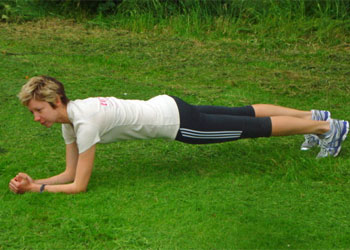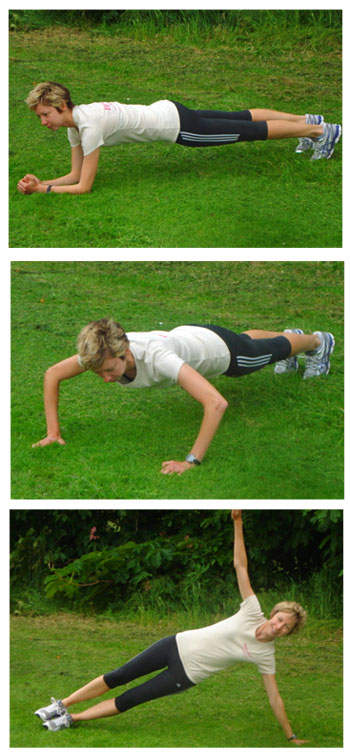Though Trigirl ambassador Rachael Willis is a relative novice when it comes to triathlon, she’s no beginner when it comes to sport. A lifelong athlete and freelance personal trainer, Rachael shares here a bit about core strength. What is core strength, why it’s important to triathletes and how you can get it… without the dreaded sit-up!
Core strength for triathletes. Something we’ve all heard of and all the experts talk about it. But what exactly is it, how do we get it, and do we really need it?
Are we talking about a six-pack?

Well, not exactly. The ‘core’ consists of superficial and deep layers of muscles in the abdominal region, lumbar region (lower back), and thoracic and cervical region of the spine (mid and upper back).
So while the ‘six-pack’ may be the ultimate goal for many gym-goers, triathletes require much more from their training if they are to benefit from effective core strength.
Why is it so important?
The core muscles provide a solid platform for translating power from the lower to upper body and vice versa. They are also responsible for many different movements: forward flexion, extension, lateral flexion, and rotation of the spine. The core is the source of stability and support for the body in motion.
Swim: The roll during the swim stroke should be initiated at the core to allow the shoulders and legs to rotate in unison, and to prevent unnecessary sideways movement which will slow you down.
Bike: Watch the top cyclists in the Tour de France and see how still they keep their upper bodies. A strong core ensures all the power generated by the body and legs is transferred directly downwards through the pedals – no power is lost by lateral movement.
Run: Again a strong core ensures all your energy and power is translated into forward motion; it keeps you upright and in an efficient running position; it also helps to stabilise you on uneven surfaces.
So a strong core will make you a more efficient triathlete, plus good technique will put less strain on your body leading to fewer injuries.
But sit-ups are boring…
The good news is that sit-ups are not the most effective exercise to attain a strong core. They only really work the superficial abdominal muscles, and poor technique can put a strain on your neck.
So what should I be doing?
We all have better things to be doing than spending hours in a gym so I always focus on multi-muscle exercises which make for an efficient, more interesting workout. Most of these are bodyweight exercises which means you can do them anywhere at any time – so no excuse not to fit in your core training, no matter how busy you are!
First of all, check you are properly engaging your core muscles.
The Talk Test: Lay down on your back with knees bent. Draw your abdominal muscles in towards your spine (to flatten out the natural arch). Once engaged, try to talk. If you cannot talk and breathe in and out, you are simply squeezing in your stomach. If you can talk and breathe normally while engaging your core, you are doing it right!
In my kickboxing days I quickly learnt to engage (or ‘brace’) my core effectively. Imagine someone is about to punch you in the stomach. Your body’s natural reaction will be to brace the core to counteract the punch – try it, it works!

Try the following circuit: perform each exercise one after another then rest for 60 seconds. Complete one, two, or more circuits depending on your fitness level:
- Plank (up to 90 seconds)
Rest on forearms and toes; engage the core; hold hips in line with torso. - Russian twists (up to 25 reps)
Sit on floor holding medicine ball; engage core, lean back keeping your back straight; rotate from side to side. Lift feet off floor to make it harder. - Dorsal raises (up to 20 reps)
Lie face down, fingertips on temples; slowly raise upper body off floor using lower back muscles; lower under control. - Plank to press ups (up to 10 reps each side)
Start in plank position (see above); place one hand under shoulder to extend the arm followed by the other hand to finish in a ‘press up’ position; lower back down to plank. Perform up to 10 reps on one side then switch lead hand. - Glute bridge
Lie on back, knees bent; lift hips into bridge position and squeeze the glutes to maintain position. Hold for count of 15. Then perform 15 pulses – drop hips down towards floor then squeeze glutes to push hips back up again. Then hold for 10, complete 10 pulses, hold for 5, complete 5 pulses. - Side planks (up to 60 seconds each side)
Lie on your side then lift your body up to support it on your forearm (or hand) and feet. Hold for up to 60 seconds. Repeat on other side.
If you would like any more ideas on core exercises, leave a comment and Rachael will get back to you!
To find out more about personal training with Rachael or online training options, click here.
Comments are closed.